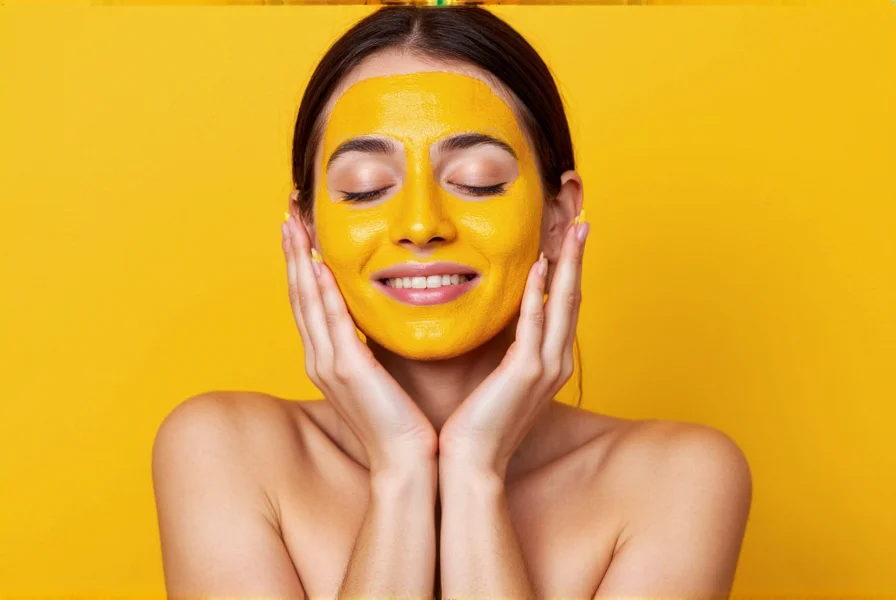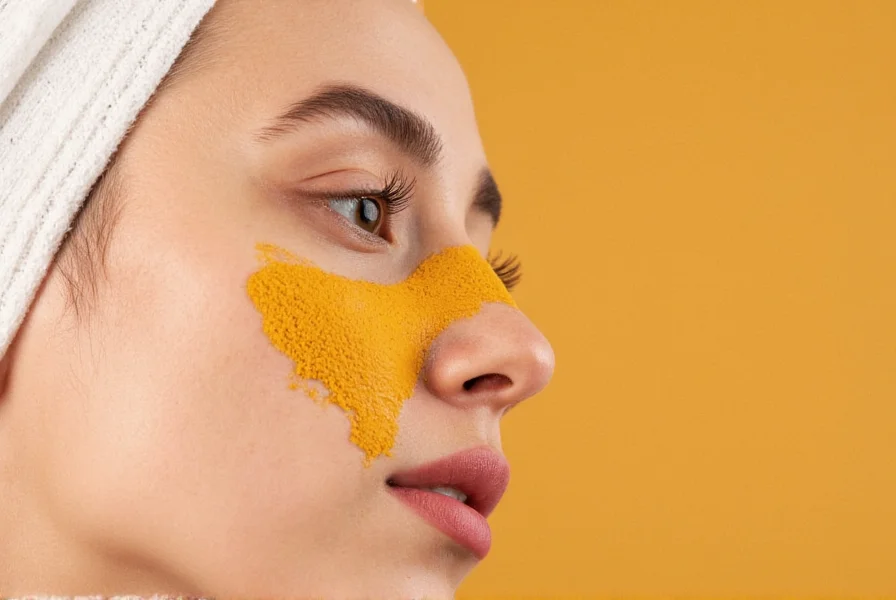For centuries, turmeric has been a cornerstone of traditional Ayurvedic and Chinese medicine for treating various skin conditions. Modern science is now validating many of these traditional uses through clinical research. The golden spice contains curcumin, which constitutes about 2-8% of turmeric and delivers most of its therapeutic benefits for skin health.
The Science Behind Turmeric's Skin Benefits
Curcumin, turmeric's primary bioactive compound, works through multiple mechanisms to improve skin health. It inhibits inflammatory pathways by suppressing molecules like NF-kB and cytokines that trigger skin inflammation. As a powerful antioxidant, curcumin neutralizes free radicals that cause oxidative stress and accelerate skin aging. These dual actions make turmeric particularly effective for addressing common skin concerns.
Key Skin Benefits of Turmeric
| Skin Benefit | How It Works | Scientific Support |
|---|---|---|
| Reduces inflammation | Inhibits inflammatory enzymes and cytokines | Multiple clinical studies show improvement in inflammatory skin conditions |
| Antioxidant protection | Neutralizes free radicals, boosts natural antioxidant enzymes | Research demonstrates protection against UV damage and oxidative stress |
| Acne treatment | Reduces inflammation, antibacterial properties | Studies show decreased acne lesions and sebum production |
| Wound healing | Promotes collagen synthesis, tissue remodeling | Clinical evidence of accelerated healing in surgical wounds |
Anti-Inflammatory Properties for Skin Conditions
Turmeric benefits for skin inflammation make it particularly valuable for conditions like eczema, psoriasis, and rosacea. When applied topically, curcumin reduces redness and swelling by inhibiting inflammatory pathways. A 2016 study published in Phytotherapy Research found that a turmeric-containing cream significantly improved symptoms in patients with psoriasis. For those searching how to use turmeric for acne treatment, its anti-inflammatory action helps reduce the redness and swelling associated with inflammatory acne lesions.
Antioxidant Protection Against Skin Aging
The antioxidant effects of turmeric combat free radicals that break down collagen and elastin. Regular use may help prevent fine lines and wrinkles while improving skin elasticity. Research in the Journal of Clinical and Aesthetic Dermatology indicates that topical curcumin formulations can protect against UV-induced skin damage, one of the primary causes of premature aging. This scientific evidence of turmeric for skin health supports its reputation as a natural anti-aging ingredient.
Turmeric for Acne and Blemish-Prone Skin
Studies show turmeric's antibacterial properties can help reduce Propionibacterium acnes, the bacteria that contributes to acne development. Its anti-inflammatory effects simultaneously calm active breakouts. A clinical trial published in Complementary Therapies in Medicine demonstrated that a turmeric-based gel reduced acne lesions by 65% after eight weeks of use. For those wondering is turmeric good for sensitive skin, it's generally well-tolerated but patch testing is recommended due to potential staining.
Wound Healing and Skin Repair
Turmeric has been used traditionally for wound healing, and modern research supports this application. Curcumin enhances the body's natural wound healing processes by increasing collagen synthesis and promoting tissue remodeling. A study in Wound Repair and Regeneration found that turmeric extract accelerated healing in surgical wounds. This makes turmeric skincare particularly valuable for post-procedure recovery or minor skin injuries.
Brightening and Evening Skin Tone
Many people search for does turmeric brighten skin naturally, and research suggests it may help reduce hyperpigmentation. Curcumin inhibits melanin production, which can lead to a more even complexion over time. Unlike harsh chemical brighteners, turmeric offers a gentler approach to addressing dark spots and melasma. For those interested in turmeric face mask for glowing skin, combining turmeric with honey or yogurt creates a soothing, brightening treatment.
How to Use Turmeric for Skin Benefits
For maximum benefits while minimizing potential staining:
- Face masks: Mix 1 teaspoon turmeric powder with 2 tablespoons plain yogurt and 1 teaspoon honey. Leave on for 15-20 minutes before rinsing.
- Spot treatment: Combine equal parts turmeric and water to form a paste for targeted application on blemishes.
- Moisturizer enhancement: Add a pinch of turmeric to your regular moisturizer for daily antioxidant protection.
- Overnight treatment: Mix turmeric with aloe vera gel for a soothing treatment that minimizes staining risk.
Always perform a patch test before full-face application. To prevent yellow staining, rinse with milk first, then water. For those developing a turmeric skincare routine for beginners, start with once-weekly applications and gradually increase frequency as your skin adjusts.

Potential Side Effects and Limitations
While generally safe, turmeric can cause yellow-orange staining on light skin tones and fabrics. Some individuals may experience mild irritation, especially with sensitive skin. Pure turmeric has low bioavailability, which is why many skincare formulations include black pepper extract (piperine) to enhance absorption. Research on natural remedies for skin brightening with turmeric shows results typically appear after 4-8 weeks of consistent use.
Scientific Evidence Review
A comprehensive review in Phytotherapy Research analyzed 23 clinical studies on turmeric for skin conditions. The review concluded that topical turmeric formulations demonstrated significant benefits for inflammatory skin conditions, wound healing, and photoprotection. However, researchers noted that more large-scale human trials are needed to establish standardized protocols. The strongest evidence supports turmeric's anti-inflammatory and antioxidant effects, with growing research on its antimicrobial properties for acne treatment.
Practical Recommendations
For optimal results when incorporating turmeric into your skincare regimen:
- Choose high-quality, organic turmeric powder or standardized curcumin extracts
- Combine with complementary ingredients like honey (antibacterial) or yogurt (soothing)
- Apply in the evening to minimize sun exposure after application
- Be consistent—most benefits appear after 4-8 weeks of regular use
- Consult a dermatologist if you have severe skin conditions or are using prescription treatments
Conclusion
Turmeric offers multiple evidence-backed benefits for skin health through its anti-inflammatory, antioxidant, and antimicrobial properties. While not a miracle cure, it can be a valuable addition to a comprehensive skincare routine when used appropriately. The scientific evidence supporting turmeric for skin health continues to grow, validating many of its traditional uses. As with any natural remedy, manage expectations and understand that results vary based on individual skin types and conditions.
How long does it take to see results from using turmeric on skin?
Most people notice improvements in skin texture and reduced inflammation within 2-4 weeks of regular use. Significant changes in hyperpigmentation or acne typically require 6-8 weeks of consistent application. Clinical studies show maximum benefits appear after 8-12 weeks of daily or near-daily use.
Can turmeric permanently lighten skin tone?
Turmeric does not permanently lighten natural skin tone. It may temporarily reduce hyperpigmentation and create a more even complexion by inhibiting melanin production. Any lightening effects are reversible and require ongoing use to maintain. Turmeric works best for addressing specific dark spots rather than overall skin lightening.
Does turmeric help with acne scars?
Yes, turmeric may help improve the appearance of acne scars through multiple mechanisms. Its anti-inflammatory properties reduce redness in newer scars, while its promotion of collagen synthesis can help remodel older, textured scars. Research shows turmeric's antioxidant effects also protect healing tissue. For best results with acne scars, combine turmeric with other proven ingredients like vitamin C or niacinamide.
Can I leave turmeric on my face overnight?
Yes, you can leave turmeric on your face overnight, but with precautions. Mix it with aloe vera gel instead of water to reduce staining risk, and apply a thin layer. Place an old towel on your pillowcase as protection. Rinse thoroughly in the morning with milk first, then water. Those with lighter skin tones should start with shorter overnight applications (2-3 hours) to assess staining potential.
Is turmeric safe for all skin types?
Turmeric is generally safe for most skin types but requires caution with very fair complexions due to potential yellow staining. Those with sensitive skin should patch test first, as some individuals may experience mild irritation. People with known allergies to ginger or other rhizomes should avoid turmeric. When used properly in appropriate concentrations, turmeric benefits skin across various skin types, from oily to dry.











 浙公网安备
33010002000092号
浙公网安备
33010002000092号 浙B2-20120091-4
浙B2-20120091-4